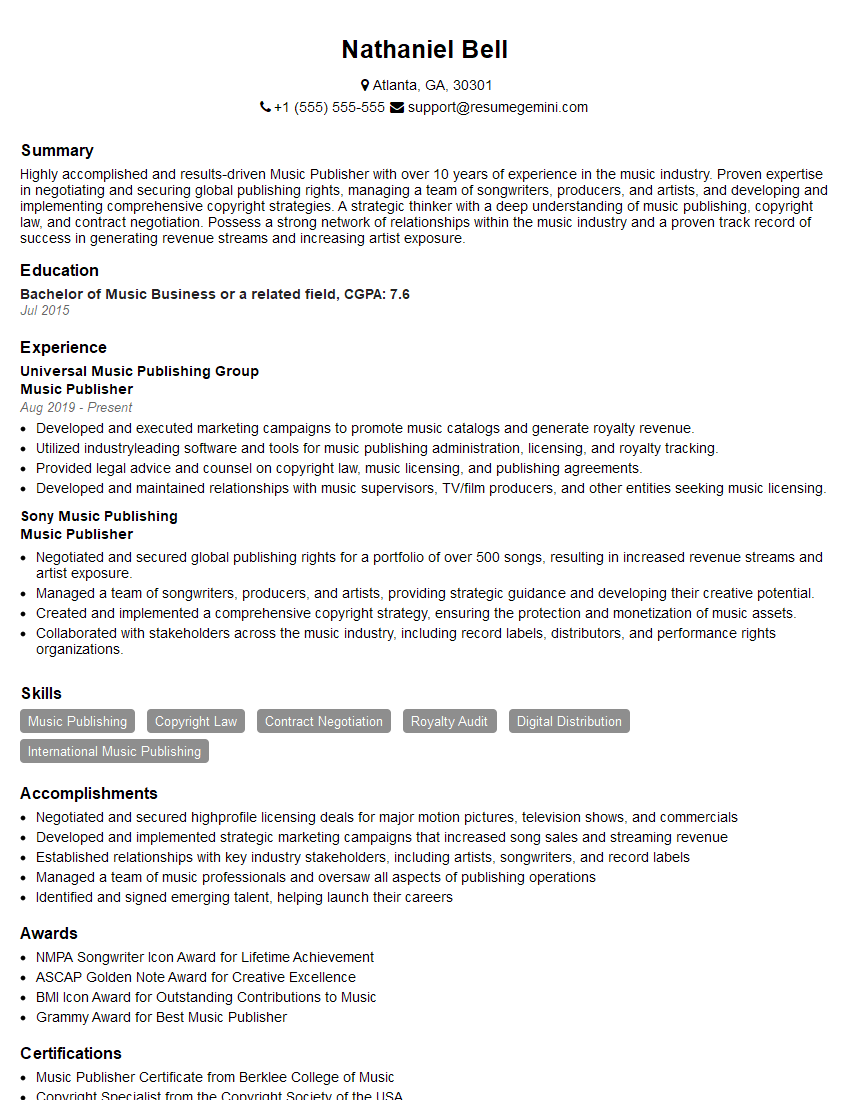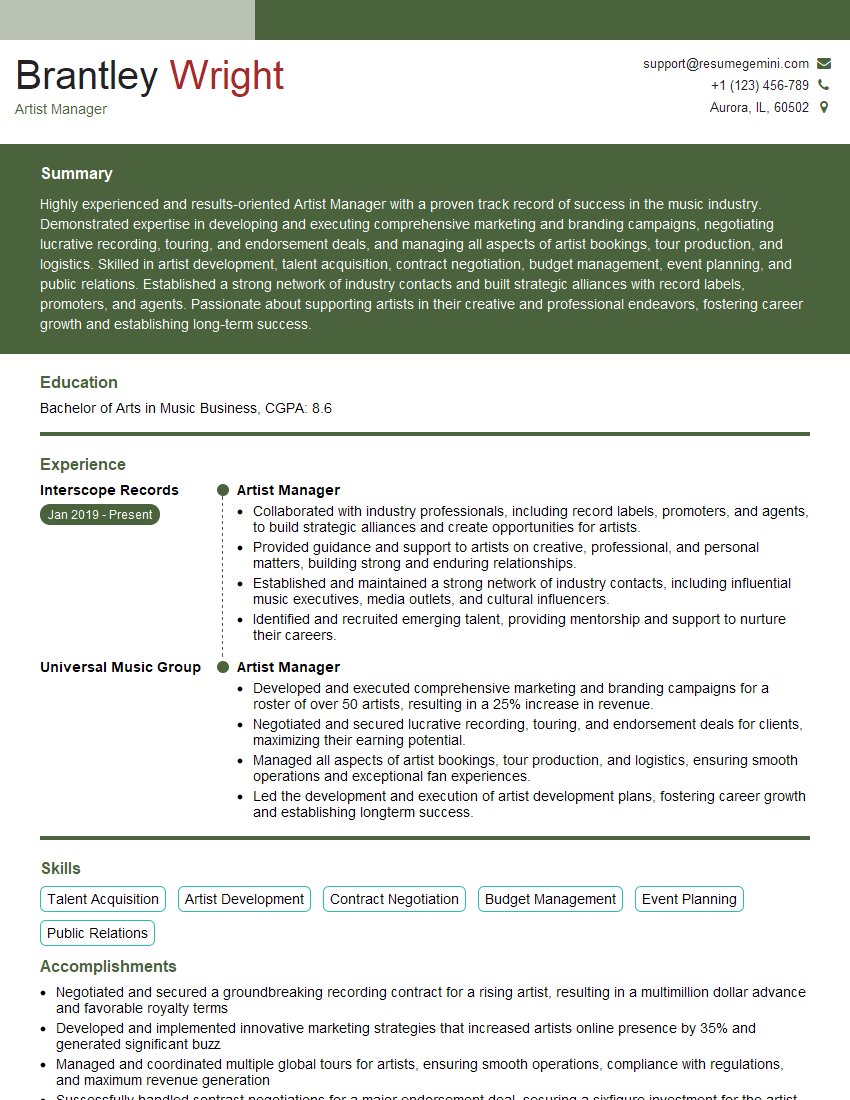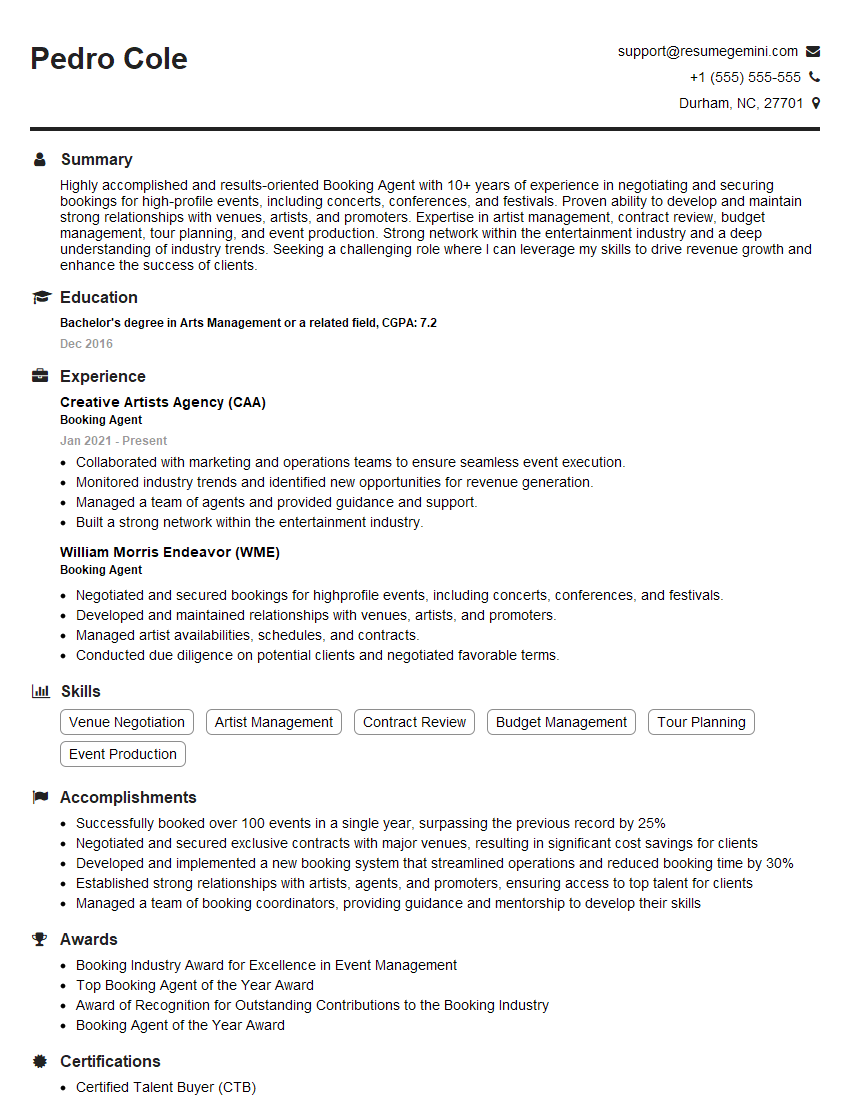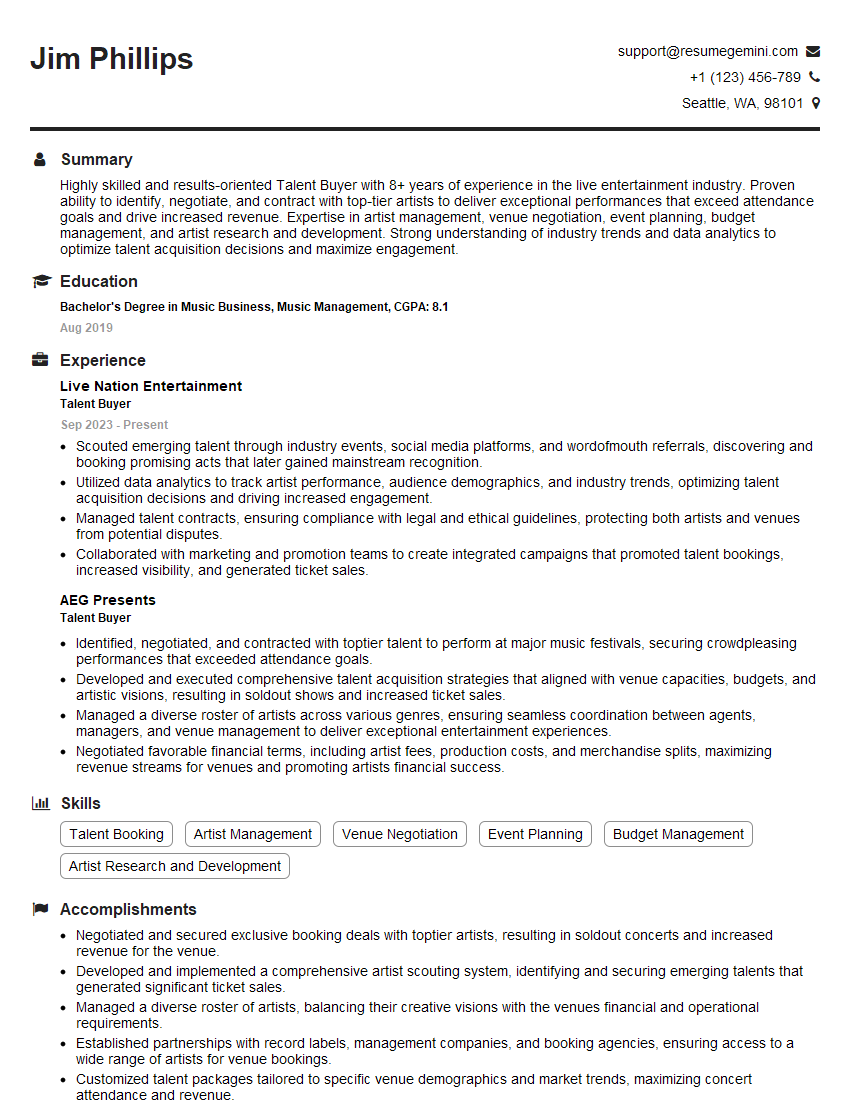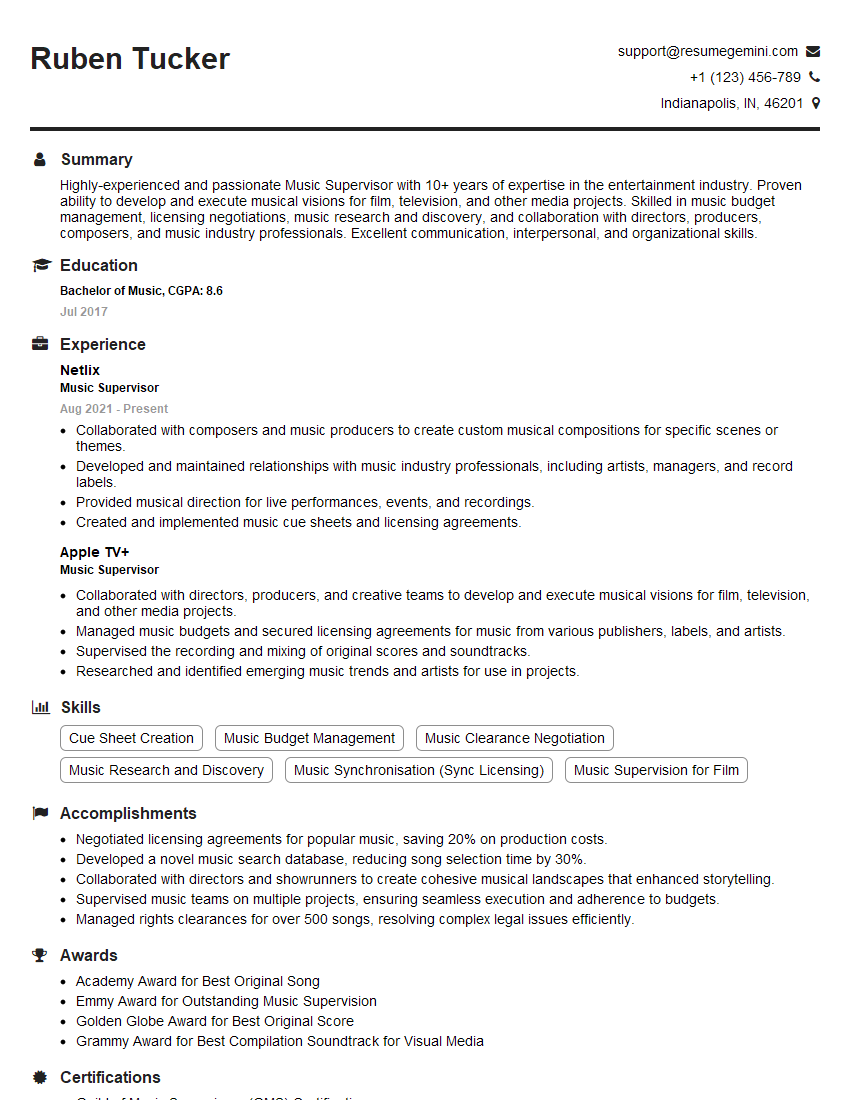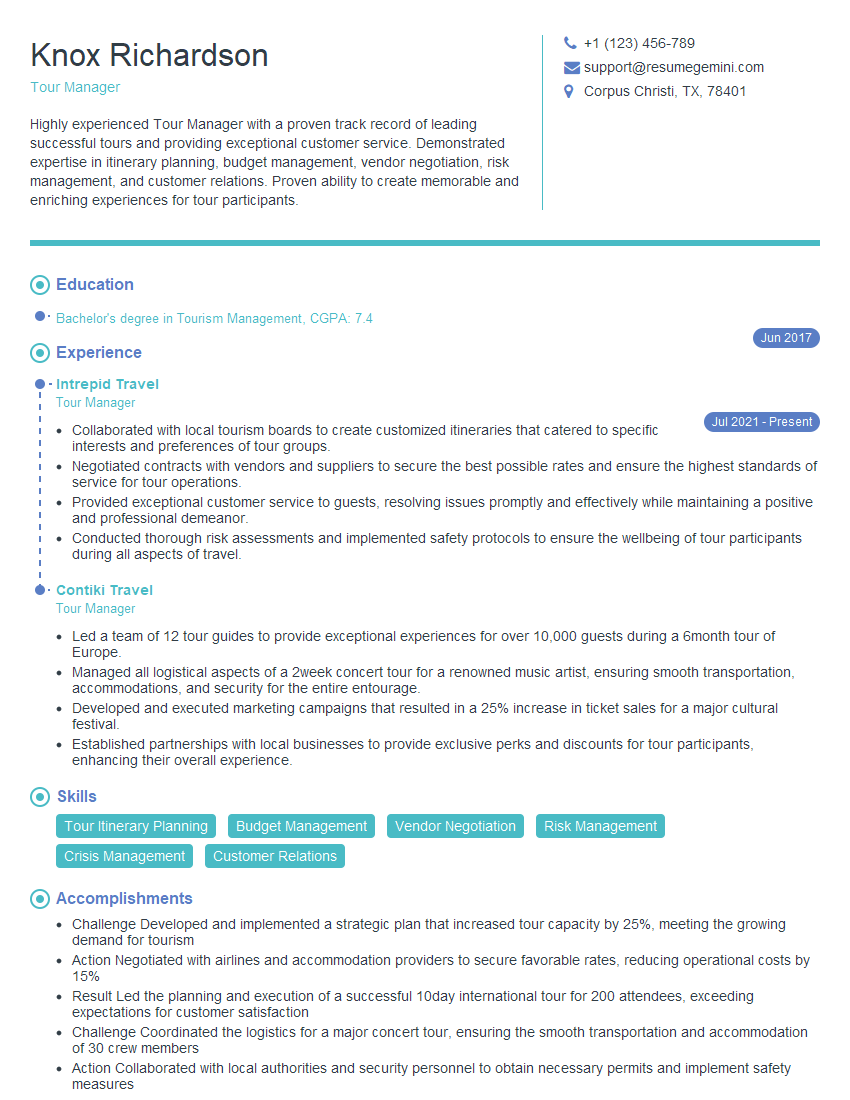Preparation is the key to success in any interview. In this post, we’ll explore crucial Collaboration and Networking within the Music Industry interview questions and equip you with strategies to craft impactful answers. Whether you’re a beginner or a pro, these tips will elevate your preparation.
Questions Asked in Collaboration and Networking within the Music Industry Interview
Q 1. Describe your experience building and maintaining professional relationships within the music industry.
Building and maintaining professional relationships in the music industry is like cultivating a garden – it requires consistent nurturing, careful tending, and a genuine appreciation for the diverse plants (people) within it. My approach centers around building genuine connections based on mutual respect, trust, and shared goals.
This involves active listening during conversations, remembering details about individuals and their projects, and consistently following up. I attend industry events, networking sessions, and conferences to expand my network organically. I also actively participate in online communities and forums related to music production, marketing, and management to connect with professionals across various disciplines. Maintaining these relationships involves consistent communication, offering help where possible, and celebrating successes together. I regularly reach out to my contacts, not just when I need something, but to share relevant industry news or congratulate them on achievements.
- Example: I’ve maintained a strong relationship with a sound engineer for over five years. This started with a simple introduction at a conference, followed by consistent communication and collaborative projects. This relationship has resulted in numerous successful recordings and valuable industry insights.
Q 2. How have you leveraged your network to secure opportunities for artists or projects?
My network has been instrumental in securing opportunities for artists and projects. It’s not just about knowing people, but about understanding their strengths and how they can contribute to a specific project’s success. I often act as a connector, introducing artists to managers, producers, or labels that would be a good fit based on their style and goals.
For example, I once connected a talented indie artist with a renowned producer through my network. The producer was looking for new talent, and the artist was seeking a professional to help refine their sound. This connection led to the artist securing a record deal. Leveraging my network also extends to identifying funding opportunities, securing performance venues, and facilitating collaborations across different artistic disciplines. Building trust within the network is key; people are more likely to help if they trust your judgment and the integrity of your intentions.
Q 3. Explain a time you had to negotiate a collaborative agreement. What was the outcome?
Negotiating collaborative agreements requires careful planning and a clear understanding of each party’s contributions and expectations. One instance involved negotiating a songwriting credit split for a collaborative project. Three songwriters were involved, each with different levels of contribution. The initial discussions were quite tense, with differing views on the value of each contribution. My approach involved a structured process:
- Clearly Define Contributions: We meticulously documented each songwriter’s specific contributions, from melody and lyrics to arrangement and production elements. This involved detailed notes, emails, and even recording sessions logs.
- Establish Fair Value: We referenced industry standards for songwriting credit splits and considered each songwriter’s experience and the overall impact of their input on the final song.
- Open and Transparent Communication: I facilitated open communication, encouraging each party to express their concerns and perspectives. This required active listening and a willingness to compromise.
- Written Agreement: The outcome was a mutually agreed-upon written agreement clearly outlining each songwriter’s credit, royalties, and responsibilities.
This process, while challenging, resulted in a fair and satisfactory agreement that maintained positive working relationships among the songwriters.
Q 4. Detail your experience working with diverse teams in music production or project management.
My experience with diverse teams in music production and project management highlights the value of inclusive collaboration. Successful projects rely on harnessing the unique skills and perspectives of individuals from various backgrounds – musicians, engineers, producers, marketers, and managers. This requires strong communication, cultural sensitivity, and an understanding of individual work styles. I utilize project management tools to streamline workflow, ensure transparency, and facilitate communication across diverse teams. For example, utilizing platforms like Asana or Trello ensures that all team members are informed and on the same page regarding tasks, deadlines, and progress.
In a recent project, our team included members from different countries, each with their unique cultural norms. To manage this effectively, we established clear communication protocols, scheduled regular virtual meetings, and used translation tools when necessary. Understanding and respecting these differences enhanced team cohesion and led to a more creative and enriching collaboration. I also prioritize creating a psychologically safe environment where team members feel comfortable sharing ideas and concerns without fear of judgment. This fosters trust and facilitates open dialogue, which is essential for successful collaborations within diverse teams.
Q 5. How do you handle conflicts that arise within collaborative music projects?
Conflicts in collaborative projects are inevitable. My approach focuses on addressing them constructively and proactively. The first step involves identifying the root cause of the conflict through open and empathetic communication. I encourage all parties to express their perspectives without interruption. Once the issue is clear, I facilitate a collaborative problem-solving process. This might involve brainstorming solutions together, negotiating compromises, or mediating disagreements.
It’s crucial to maintain a focus on the project’s goals and to avoid personal attacks. If the conflict persists, involving a neutral third party (such as a mediator or mentor) can be helpful. Documentation of the conflict and the agreed-upon solution is crucial for transparency and to prevent future misunderstandings. The goal isn’t to eliminate conflict entirely, but to learn from it and improve the collaboration process for future projects. This approach builds trust within the team and strengthens the relationships involved.
Q 6. What strategies do you use to build rapport and trust with individuals in the music industry?
Building rapport and trust is paramount in the music industry. It’s about demonstrating genuine interest in others and their work, not just what they can do for you. I prioritize active listening, showing empathy, and being reliable. This means following through on commitments and being available for support when needed. Taking the time to understand individuals’ career aspirations and goals helps build stronger relationships.
In practice, I try to create meaningful connections by engaging in conversations beyond professional topics. Asking about their personal interests, sharing relevant experiences, and remembering details about their lives demonstrate genuine care. I also utilize social media strategically to stay connected and engage with people’s content. This fosters a sense of community and strengthens relationships. Ultimately, trust is built over time through consistent actions that demonstrate integrity, reliability, and genuine respect. This builds a strong foundation for long-term collaboration and mutual success.
Q 7. Describe your approach to identifying and fostering key relationships for career advancement.
Identifying and fostering key relationships for career advancement requires a strategic and proactive approach. I use a combination of methods to achieve this: I actively participate in industry events and workshops, seeking out individuals who are leaders in their fields. I seek mentorship from experienced professionals, learning from their expertise and experience. I also identify potential collaborators who share similar goals and values. These connections are not just transactional, but are built on mutual respect and a shared vision.
For example, I’ve proactively sought mentorship from a seasoned music manager. This involved researching their work, expressing my admiration for their accomplishments, and requesting informational interviews. This relationship has provided valuable guidance, industry insights, and networking opportunities. Similarly, identifying and collaborating with talented artists allows for mutual benefit and strengthens our professional networks. These proactive steps, coupled with a consistent effort to maintain existing relationships, provide a robust foundation for sustainable career growth within the dynamic landscape of the music industry.
Q 8. How do you stay informed about emerging trends and opportunities in the music industry’s collaborative landscape?
Staying ahead in the ever-evolving music industry collaboration landscape requires a multi-pronged approach. It’s not enough to just passively observe; active engagement is key.
- Industry Publications and Blogs: I religiously follow publications like Billboard, Music Business Worldwide, and Hypebot, along with specialized blogs focusing on music technology and collaboration tools. These provide insights into emerging trends, new technologies, and successful collaborative models.
- Conferences and Workshops: Attending industry events like South by Southwest (SXSW), MIDEM, and smaller, niche conferences allows for direct networking and exposure to innovative approaches. It’s a great way to learn from experts and discover emerging trends firsthand.
- Podcasts and Webinars: I dedicate time to listening to podcasts and attending webinars featuring industry leaders discussing current challenges and solutions. This passive learning is crucial for staying informed.
- Networking with Peers: Maintaining a robust network of contacts within the industry is vital. Regularly engaging with colleagues through informal chats, online groups, and professional organizations provides invaluable insights and early warnings about emerging opportunities.
By combining these methods, I create a holistic view of emerging trends and opportunities, allowing me to adapt and innovate within my own collaborations.
Q 9. How do you utilize social media and other platforms to enhance your professional network?
Social media and other platforms are essential tools for building and nurturing my professional network. I approach it strategically, prioritizing quality over quantity.
- LinkedIn: This is my primary professional networking platform. I maintain a detailed profile, actively engage in relevant groups, and participate in industry discussions. I connect with individuals whose work I admire or whose expertise aligns with my own.
- Twitter and Instagram: These platforms are used to share my work, engage in industry conversations, and discover emerging artists and collaborators. I strategically use hashtags and engage with other users to broaden my reach.
- Online Music Communities: I participate in online forums and communities dedicated to music production, songwriting, and other areas relevant to my work. These provide opportunities to connect with like-minded professionals, exchange ideas, and offer support.
- Direct Outreach: I don’t shy away from directly contacting individuals whose work I admire. A thoughtfully crafted message expressing genuine interest can often lead to fruitful connections.
The key is to be authentic, engage genuinely, and provide value to the community. Simply broadcasting my achievements isn’t effective; meaningful interaction is paramount.
Q 10. How do you manage multiple collaborative projects simultaneously while maintaining high quality?
Juggling multiple collaborative projects requires a robust organizational system and a commitment to efficient time management. It’s not about doing more, but about doing it smarter.
- Project Management Software: I rely heavily on project management tools like Asana or Trello to track tasks, deadlines, and progress across all projects. This provides a centralized view and helps prevent overlaps or missed deadlines.
- Prioritization and Time Blocking: I carefully prioritize tasks based on urgency and importance using methods like the Eisenhower Matrix. Time blocking helps dedicate specific periods to each project, preventing task switching and improving focus.
- Clear Communication: Maintaining open and consistent communication with all collaborators is essential. Regular check-ins, progress reports, and prompt responses to queries keep everyone informed and prevent misunderstandings.
- Delegation and Trust: I delegate tasks effectively based on team members’ strengths. Trusting my team to deliver high-quality work is crucial for efficiency. However, I always maintain oversight to ensure progress remains on track.
Maintaining high quality requires a meticulous approach. Rushing to meet deadlines at the expense of quality is counterproductive. I prioritize quality assurance steps within the workflow to ensure the final output meets the highest standards.
Q 11. Describe a time you had to persuade a stakeholder to adopt a new collaborative approach.
In one project, a record label was hesitant to adopt a cloud-based collaborative platform for songwriting and production. They were comfortable with traditional email and file-sharing methods, citing concerns about data security and the learning curve for their team.
My strategy involved a three-step approach:
- Demonstration: I organized a hands-on demonstration showcasing the platform’s user-friendliness and security features. This addressed their concerns directly.
- Highlighting Benefits: I focused on the platform’s advantages, such as real-time collaboration, version control, and streamlined communication. I quantified the potential time and cost savings compared to their current methods.
- Phased Implementation: Instead of a complete overhaul, I suggested a phased approach, starting with a small pilot project to test the platform and build confidence within the team. This minimized disruption and risk.
This approach successfully persuaded the label to adopt the new platform, ultimately leading to improved efficiency and stronger collaboration among the songwriting team.
Q 12. How do you adapt your communication style to effectively work with people from different musical backgrounds?
Adapting communication style is crucial when working with diverse musical backgrounds. It’s about understanding individual preferences and communication styles, and then tailoring my approach accordingly.
- Active Listening: I start by actively listening to understand their perspectives, communication preferences, and working styles. This helps me adapt my own communication to ensure clear understanding.
- Empathy and Respect: I approach each collaboration with empathy and respect, recognizing that different backgrounds often lead to differing working styles and expectations. This fosters trust and builds a collaborative environment.
- Clear and Concise Language: I avoid using jargon or technical terms that might confuse those unfamiliar with specific musical concepts. Using clear and concise language ensures everyone is on the same page.
- Visual Aids and Demonstrations: Where necessary, I use visual aids or demonstrations to explain complex concepts, ensuring that everyone understands, regardless of their background.
For example, when working with a more classically trained musician, I might use formal musical notation and terminology. However, when working with a producer with a more electronic background, I’d use more informal language and focus on practical results.
Q 13. How do you assess the strengths and weaknesses of team members in collaborative projects?
Assessing team members’ strengths and weaknesses is an ongoing process, not a one-time evaluation. It requires observation, communication, and a willingness to provide constructive feedback.
- Observation During Projects: I observe team members’ contributions throughout the project, paying attention to their strengths, weaknesses, and working styles.
- Regular Feedback Sessions: I conduct regular feedback sessions to understand team members’ self-perceptions and areas where they feel they could improve.
- 360-Degree Feedback: Where possible, I encourage 360-degree feedback, where team members provide feedback on each other’s contributions. This provides a more holistic perspective.
- Skill Assessments: In some instances, formal skill assessments or tests might be appropriate, especially when assessing specific technical skills.
This information is used to assign tasks effectively, provide targeted support, and foster professional growth within the team. It is crucial to approach this process constructively, focusing on improvement and growth rather than criticism.
Q 14. How do you effectively delegate tasks and responsibilities within a music production team?
Effective delegation in a music production team hinges on understanding individual strengths and matching tasks accordingly. It’s not about simply assigning tasks, but about empowering team members to contribute their best work.
- Clear Task Definition: I provide clear and concise task descriptions, including deadlines, expected outcomes, and necessary resources.
- Matching Tasks to Skills: I carefully assign tasks based on individual team members’ skills and experience. This ensures the right person is doing the right job.
- Providing Resources and Support: I ensure team members have the necessary resources, tools, and support to complete their tasks effectively. This may include providing training, mentorship, or access to specialized software.
- Regular Check-ins and Feedback: I conduct regular check-ins to monitor progress, provide feedback, and address any challenges or roadblocks. This maintains accountability and ensures the project stays on track.
- Authority and Accountability: Clear lines of authority and accountability are essential. Each team member should understand their responsibilities and the consequences of not meeting expectations.
Delegation isn’t about shirking responsibility; it’s about building a strong team and empowering individuals to thrive. It’s about creating a synergistic environment where the whole is greater than the sum of its parts.
Q 15. Explain your process for selecting collaborators for a particular music project.
Collaborator selection is crucial for a successful music project. It’s not just about talent; it’s about synergy, work ethic, and shared vision. My process begins with clearly defining the project’s scope and desired outcome. What genre are we aiming for? What kind of sound are we creating? What instruments and vocal styles are needed? Then, I identify potential collaborators based on their skills and reputation, researching their past work to ensure alignment with my vision. I look beyond technical proficiency to assess their personality and collaborative style – can they communicate effectively, adapt to change, and contribute positively to the team dynamic? I often reach out to individuals via their websites, social media, or through mutual connections within the industry. The final selection involves a discussion of the project’s goals, expectations, and scheduling to ensure everyone is on the same page before we even begin.
For example, when working on a project requiring complex jazz arrangements, I sought out a saxophonist with a proven track record in improvisational music and a collaborative spirit. Initial conversations focused not just on their musical skills, but also on how they handled feedback and worked within deadlines. This ensured a smooth process throughout the project.
Career Expert Tips:
- Ace those interviews! Prepare effectively by reviewing the Top 50 Most Common Interview Questions on ResumeGemini.
- Navigate your job search with confidence! Explore a wide range of Career Tips on ResumeGemini. Learn about common challenges and recommendations to overcome them.
- Craft the perfect resume! Master the Art of Resume Writing with ResumeGemini’s guide. Showcase your unique qualifications and achievements effectively.
- Don’t miss out on holiday savings! Build your dream resume with ResumeGemini’s ATS optimized templates.
Q 16. How do you measure the success of a collaborative project?
Measuring the success of a collaborative music project is multifaceted. It’s not solely about chart positions or sales, though those are certainly valuable metrics. I consider several factors. First, I assess the artistic merit of the final product – did we achieve the creative vision? Did the collaboration enhance the individual contributions, creating something greater than the sum of its parts? Next, I look at the project’s impact on the collaborators themselves – did everyone learn and grow? Did their skills and reputation improve? Finally, I assess the project’s commercial success, including sales figures, streaming numbers, and critical acclaim. A truly successful project shines in all three areas.
For instance, a project might not have topped the charts but garnered significant critical praise and strengthened the individual careers of the collaborators, representing a successful outcome in artistic and professional terms.
Q 17. How do you provide constructive feedback to collaborators without damaging morale?
Constructive feedback is essential, but delivering it effectively requires sensitivity and empathy. I focus on the work, not the person. Instead of saying, “This melody is terrible,” I might say, “The melody here feels a bit disjointed from the overall mood. Have you considered trying this alternative phrasing?” I always start with positive reinforcement, highlighting aspects I appreciate before addressing areas for improvement. I offer specific suggestions and examples rather than vague criticisms. I encourage dialogue and two-way communication, ensuring the collaborator feels heard and valued. The goal is to foster a growth mindset, making feedback a tool for improvement rather than a source of negativity.
For example, if a vocalist’s tone feels inconsistent, I’ll point out specific segments where it works well, then gently suggest techniques for improving consistency in other sections, perhaps offering vocal exercises or recording examples.
Q 18. How do you handle disagreements among collaborators regarding creative direction?
Disagreements are inevitable in collaborative projects. My approach is to foster open communication and create a safe space for everyone to express their ideas and concerns. I encourage active listening and empathy, making sure everyone feels heard. I facilitate discussions, guiding the conversation towards finding common ground or exploring alternative solutions. If we can’t reach a consensus, a compromise or a vote might be necessary, ensuring that the final decision reflects the overall project’s best interest. It is vital to document these decisions and ensure all collaborators understand and accept the resolution.
I recall a situation where collaborators clashed over the tempo of a track. We addressed it by having each person present their rationale, then tested different tempos with the entire team. The final tempo selection wasn’t solely dictated by one person’s preference; it was a group consensus based on collective feedback and listening.
Q 19. Describe your experience with collaborative software or tools used in the music industry.
My experience with collaborative software is extensive. Soundtrap is excellent for multi-track recording and real-time collaboration. It allows multiple users to work simultaneously on a single project, regardless of their physical location. Google Drive and Dropbox are invaluable for sharing files and maintaining version control. These platforms ensure that everyone has access to the latest versions and eliminates confusion over which file is current. Slack and Discord are used extensively for quick communication and providing feedback, maintaining a fluid conversation that keeps the project moving forward. For video conferencing, Zoom is my go-to for virtual meetings and collaboration sessions.
Q 20. How do you ensure that all collaborators understand their roles and responsibilities?
Clear role definition is critical. Before starting a project, I create a detailed project plan outlining each collaborator’s responsibilities, tasks, and deadlines. This document is shared with everyone, and we discuss it thoroughly, ensuring everyone understands their contribution and how it fits into the larger picture. Regular check-ins and progress meetings help maintain accountability and address any emerging issues. Open communication channels allow for easy clarification of roles and responsibilities as the project progresses.
For example, a project might designate one person as the lead composer, another as the primary lyricist, a third as the sound engineer, and a fourth for marketing and distribution. The project plan clearly outlines each person’s tasks and reporting structure.
Q 21. How do you proactively identify and mitigate potential risks within collaborative projects?
Proactive risk mitigation is crucial. I start by identifying potential problems, such as missed deadlines, creative disagreements, technical difficulties, or financial constraints. I develop contingency plans to address each potential risk. For example, if a collaborator experiences unforeseen circumstances, we have backup plans in place. If the budget is limited, we prioritize essential tasks and explore cost-effective alternatives. Regular communication and progress monitoring help us identify emerging risks early on, allowing us to address them before they escalate. Thorough project planning and clearly defined expectations help minimize unexpected problems.
A specific example: If a key collaborator might miss a deadline due to a prior commitment, we’d preemptively assign a portion of their tasks to another team member or build extra time into the schedule.
Q 22. Describe your experience managing budgets and resources within collaborative projects.
Managing budgets and resources in collaborative music projects requires meticulous planning and transparent communication. It’s like orchestrating a symphony – each instrument (collaborator) needs its resources (time, studio access, equipment) allocated efficiently to create a harmonious whole. My approach involves:
- Detailed Budgeting: I begin with a comprehensive budget outlining all anticipated expenses, including studio time, equipment rentals, musician fees, marketing, and administrative costs. This is often done in spreadsheet software like Google Sheets, allowing for easy collaboration and tracking.
- Resource Allocation: I allocate resources based on the project timeline and each collaborator’s role and contribution. This necessitates clear communication about what’s required from each person and when.
- Regular Tracking and Reporting: Throughout the project, I track expenses against the budget. This helps identify potential overruns early on, allowing for course correction. Regular reports keep all collaborators informed of the project’s financial status.
- Contingency Planning: Unexpected costs are inevitable. A contingency fund is crucial for handling unforeseen circumstances, such as equipment malfunction or last-minute studio bookings.
For example, in a recent project involving a 5-piece band, I meticulously budgeted for studio time, individual musician fees based on experience, mixing and mastering costs, and marketing expenses for the eventual album release. Regular updates ensured transparency and prevented conflicts.
Q 23. How do you maintain positive relationships with collaborators even after a project has ended?
Maintaining positive relationships after a project concludes is vital for future collaborations and referrals. Think of it as nurturing a garden; you need to tend to it even after the initial blooms. My strategy involves:
- Post-Project Debrief: A casual meeting or call to discuss successes, challenges, and lessons learned. This fosters a sense of shared accomplishment and provides valuable feedback.
- Continued Communication: Staying in touch informally, perhaps through social media or emails, to share relevant opportunities and celebrate individual achievements helps keep the professional bond strong.
- Mutual Support: Promoting each other’s work through social media shares or recommendations signals mutual respect and creates further collaboration possibilities.
- Formal Thank You: Expressing gratitude in a personalized manner, perhaps with a handwritten note or a small gift, demonstrates professionalism and genuine appreciation.
For instance, after completing an album with a group of musicians, I organized a small celebratory dinner, and we continue to support each other’s individual projects by sharing updates and promoting new releases on social media.
Q 24. How do you handle situations where a collaborator doesn’t meet expectations?
When a collaborator doesn’t meet expectations, addressing the situation directly and professionally is crucial. It’s about constructive feedback, not blame. My approach includes:
- Private Conversation: I schedule a private meeting or call to discuss concerns calmly and respectfully. This allows for open dialogue without involving other collaborators.
- Specific Feedback: I provide concrete examples of where expectations weren’t met, focusing on the work itself, not the individual’s character.
- Collaborative Problem-Solving: Instead of assigning blame, I work with the collaborator to identify the root causes and explore solutions. This could involve adjusting deadlines, providing additional support, or clarifying roles and responsibilities.
- Documentation: If the issue persists, it’s essential to document the conversations and agreements reached. This helps avoid future misunderstandings.
In a scenario where a musician consistently missed deadlines, I scheduled a meeting to understand the reason. We collaboratively adjusted the timeline and established a new communication system that helped them meet the revised deadlines effectively.
Q 25. How do you balance the need for collaboration with the need for individual creative expression?
Balancing collaboration and individual creative expression is like finding the perfect harmony in a song. Each voice (individual artist) needs its space to shine, yet they need to complement the overall composition. My approach involves:
- Clear Roles and Responsibilities: From the outset, defining individual roles ensures each collaborator understands their contribution’s scope and allows for creative autonomy within those boundaries.
- Open Communication: Regular check-ins facilitate a space for sharing ideas, addressing concerns, and ensuring individual creative visions align with the overall project vision.
- Respectful Feedback: Constructive feedback provides a safe environment for individual expression and refinement without stifling creativity. It’s important to make sure all voices are heard.
- Shared Vision: Ensuring everyone involved understands and buys into the overall vision for the project is crucial. This helps everyone work toward a shared creative goal.
In one project, we established ‘jam sessions’ allowing for individual improvisation within the boundaries of the genre. This helped develop the initial musical sketches, ensuring a balanced expression of individual creativity within a unified framework.
Q 26. What are some common challenges you’ve encountered in collaborative music projects?
Collaborative music projects, while rewarding, present unique challenges. Some common ones include:
- Creative Differences: Conflicts can arise from differing artistic visions or approaches, making consensus-building crucial.
- Communication Breakdown: Ineffective communication can lead to misunderstandings, missed deadlines, and frustration.
- Scheduling Conflicts: Coordinating schedules across multiple collaborators can be difficult, especially when dealing with busy musicians.
- Unclear Roles and Responsibilities: Vague expectations can cause confusion and duplicated effort.
- Budgetary Constraints: Limited resources can force tough decisions and compromises.
For example, reconciling the artistic visions of multiple songwriters required extensive open discussions, compromise, and a willingness from everyone to incorporate each other’s unique contributions to the overall songwriting process.
Q 27. How have you used networking to overcome challenges in your career?
Networking has been instrumental in overcoming career challenges. It’s about building a strong professional community. My strategy includes:
- Industry Events: Attending conferences, workshops, and concerts allows me to meet other professionals and learn about new opportunities.
- Online Platforms: Utilizing platforms like LinkedIn helps connect with professionals in the music industry and stay updated on trends.
- Mentorship: Seeking guidance from experienced professionals provides invaluable advice and support.
- Collaboration: Working on projects with talented individuals expands my network and exposes me to new perspectives.
For example, attending a music industry conference led to a collaboration with a renowned producer, significantly advancing my career. My professional network has also helped me navigate challenging situations by providing advice and connecting me with the right resources.
Q 28. How do you ensure intellectual property is protected in collaborative music projects?
Protecting intellectual property (IP) in collaborative projects is paramount. This requires proactive measures from the outset. My approach involves:
- Written Agreements: A detailed contract outlines each collaborator’s contributions, ownership rights, and usage restrictions for the created work. This should include specifics on songwriting credits, publishing rights, and performance royalties.
- Copyright Registration: Registering the musical work with relevant copyright authorities secures legal protection for the creators.
- Clear Ownership Allocation: The contract should clearly state who owns what percentage of the IP rights. This can be based on contribution, or a pre-agreed percentage.
- Confidentiality Agreements (NDAs): In cases where sensitive information or unreleased material is involved, NDAs are essential to prevent unauthorized disclosure.
A sample clause in a collaboration agreement might state: "Each collaborator retains ownership of their individual contributions to the work. The copyright for the final work will be jointly owned by all collaborators in equal shares, unless otherwise specified."
Key Topics to Learn for Collaboration and Networking within the Music Industry Interview
- Building and Maintaining Professional Relationships: Understanding the nuances of networking within the music industry, from informal meet-ups to formal industry events. This includes strategies for building authentic connections and maintaining those relationships over time.
- Effective Communication & Collaboration Styles: Exploring various communication styles and their effectiveness in diverse team settings. This includes practical application in scenarios such as collaborative songwriting, studio recording, and project management within a band or larger organization.
- Conflict Resolution and Negotiation: Developing skills in navigating disagreements and finding mutually beneficial solutions within collaborative projects. This encompasses practical strategies for resolving creative differences and managing expectations within a team environment.
- Team Dynamics and Leadership: Understanding how teams function, identifying different leadership styles, and applying appropriate strategies for contributing effectively as a team member and/or leader within a musical context. This includes recognizing and addressing potential interpersonal challenges within a team.
- Understanding Industry Structures & Roles: Developing a comprehensive understanding of the various roles and responsibilities within the music industry, from A&R to publishing, and how collaboration and networking play a crucial role across these different sectors.
- Leveraging Online Platforms for Networking: Understanding the effective use of social media and online professional networking platforms (LinkedIn) to build professional connections and stay up-to-date on industry trends.
- Contract Negotiation and Intellectual Property: A basic understanding of music industry contracts and the importance of protecting intellectual property in collaborative projects.
Next Steps
Mastering collaboration and networking is paramount for career advancement in the dynamic music industry. Strong interpersonal skills, effective communication, and a wide professional network are essential for securing opportunities and building a successful career. To maximize your job prospects, creating an ATS-friendly resume is crucial. ResumeGemini is a trusted resource that can help you build a professional resume that stands out. Examples of resumes tailored to showcasing your skills in Collaboration and Networking within the Music Industry are available, allowing you to present your experience effectively and increase your chances of landing your dream job.
Explore more articles
Users Rating of Our Blogs
Share Your Experience
We value your feedback! Please rate our content and share your thoughts (optional).
What Readers Say About Our Blog
Hello,
We found issues with your domain’s email setup that may be sending your messages to spam or blocking them completely. InboxShield Mini shows you how to fix it in minutes — no tech skills required.
Scan your domain now for details: https://inboxshield-mini.com/
— Adam @ InboxShield Mini
Reply STOP to unsubscribe
Hi, are you owner of interviewgemini.com? What if I told you I could help you find extra time in your schedule, reconnect with leads you didn’t even realize you missed, and bring in more “I want to work with you” conversations, without increasing your ad spend or hiring a full-time employee?
All with a flexible, budget-friendly service that could easily pay for itself. Sounds good?
Would it be nice to jump on a quick 10-minute call so I can show you exactly how we make this work?
Best,
Hapei
Marketing Director
Hey, I know you’re the owner of interviewgemini.com. I’ll be quick.
Fundraising for your business is tough and time-consuming. We make it easier by guaranteeing two private investor meetings each month, for six months. No demos, no pitch events – just direct introductions to active investors matched to your startup.
If youR17;re raising, this could help you build real momentum. Want me to send more info?
Hi, I represent an SEO company that specialises in getting you AI citations and higher rankings on Google. I’d like to offer you a 100% free SEO audit for your website. Would you be interested?
Hi, I represent an SEO company that specialises in getting you AI citations and higher rankings on Google. I’d like to offer you a 100% free SEO audit for your website. Would you be interested?
good
